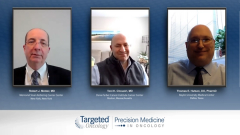
Prevalence of Actionable Biomarkers in Clear-Cell RCC
Thomas Hutson, DO, PharmD, and Toni Choueiri, MD, discuss the available biomarkers, predictive biomarkers, and clinical predictors that are currently used in metastatic clear-cell renal cell carcinoma, as well as risk status.
Episodes in this series

Toni K. Choueiri, MD: The tissue blood biomarkers have been things I worked on since my time at Cleveland Clinic. I was looking at VHL alteration to see if—what Tom mentioned—VHL was altered, you had a higher level of HIF [hypoxia-inducible factor] and VEGF, and perhaps a better response to the VEGF inhibitor. This did not pan out. Tom and looked at that. That’s where it started a long time ago. With the platform and the technology being developed, looking at next-generation sequencing [NGS] at whole-exome, whole-genome, RNA-Seq, some proteomics or immunofluorescence with pathology colleagues. We still have not had anything, unfortunately, that made it to the clinical domain and to daily practice. But we have unraveled—our group and others—RNA signature for antiangiogenics like sunitinib for immune-based therapies. But nothing has led us to call and test for a biomarker at baseline and, based on it, choose a therapy. In papillary renal cell, which you haven’t asked about, MET seems to be quite relevant in 30% to 40% of patients. We reported on sorafenib perhaps having some activity only in patients with MET alterations. But we can continue this only if you want this journey for biomarkers because have new technologies. We just had 2 papers last week with single-cell sequencing and cancer cells. They taught us a lot, so when the time is ready, we know where to go. One thing I want to say, Bob, is that with the combination—and we going to talk about not 1 or 2 drugs but also 3 drugs—if we are to achieve a very high response rate in biomarkers, it may become a bit harder. We will continue for the time being.
Thomas E. Hutson, DO, PharmD: Unfortunately, what we’ve looked at so far hasn’t panned out at the level as far as allowing a clinician to say yes or no to the use of a checkpoint inhibitor in kidney cancer, as it has in some other tumor types. For kidney cancer, PD-L1 expression can enrich or allow you to separate out a population that seems to do better with the checkpoint inhibitor. But PD-L1 nil or absent tumors still seemed in clinical trials to do better than the control arm or the placebo arm. It’s not as much of a distinguishing factor because we would use the drug anyway, because it does better or provides benefit over what we had been doing in the past. I do think what Toni mentioned about NGS and being able to separate patients into a certain genotype that then translates into a particular phenotype in response will be useful. We may find something similar to PD-L1 and PD-1 expression and immune signature—a hot tumor, if you will, that would respond better. But right now, I have not been overwhelmed by doing a simple PD-1 or PD-L1 test.
It’s a 2-fold answer. It’s what is realistic and relevant to do in practice and then what my practice or what the payers make me do. I’m in a situation at US Oncology where we use an electronic medical record, which essentially requires me—whether I believe in them or not—to select the appropriate risk group for my patient. That ties directly into clear value pathways, which are linked into an NCCN [National Comprehensive Cancer Administration] Guidelines approach and then helps me select agents that way. Is that useful from a biologic standpoint? Right now, that’s about all we have. For reasons that we haven’t been fully able to explain, it appears that certain risk groups relate to or mark a certain biology of the tumor. We expect a favorable-risk group to seem to do well, regardless of what strategy we use. They do very well with VEGF inhibitors, for instance. And we think, at least data would suggest that maybe some of the poor-risk individuals may have underlying biology that makes them respond better to, for instance, checkpoint inhibitor therapy. Nothing, unfortunately, that we found so far has a 100% correlation. What I’m saying is just generalities. If you look at the preponderance of the data, it appears that the classification based on prognostic risk does correlate with some underlying biology based on how the tumors respond to the different therapies. Yet we haven’t been able to dissect that out fully.
This transcript was edited for clarity.







































